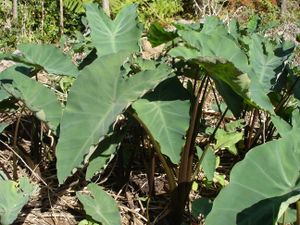Note: This is a project under development. The articles on this wiki are just being initiated and broadly incomplete. You can Help creating new pages.
Difference between revisions of "Colocasia esculenta - Aaluki, Green Taro"
| Line 1: | Line 1: | ||
| − | [[File:Aaluki.JPG|thumb| | + | [[File:Aaluki.JPG|thumb|leftt|''Aaluki'', ''Keshavanagadde'', ''Taro'']] |
'''Aaluki''' or '''Taro''' commonly refers to the plant Colocasia esculenta, the most widely cultivated species of several plants in the Araceae family which are used as vegetables for their [[corm]], leaves, and petioles. Thus, this article describes the "dasheen" form of taro; another variety of taro is known as eddoe or Colocasia antiquorum. Other species of taro include giant taro (Alocasia macrorrhizos), swamp taro (Cyrtosperma merkusii), and arrowleaf elephant's ear (Xanthosoma sagittifolium). | '''Aaluki''' or '''Taro''' commonly refers to the plant Colocasia esculenta, the most widely cultivated species of several plants in the Araceae family which are used as vegetables for their [[corm]], leaves, and petioles. Thus, this article describes the "dasheen" form of taro; another variety of taro is known as eddoe or Colocasia antiquorum. Other species of taro include giant taro (Alocasia macrorrhizos), swamp taro (Cyrtosperma merkusii), and arrowleaf elephant's ear (Xanthosoma sagittifolium). | ||
Revision as of 10:25, 23 March 2018
Aaluki or Taro commonly refers to the plant Colocasia esculenta, the most widely cultivated species of several plants in the Araceae family which are used as vegetables for their corm, leaves, and petioles. Thus, this article describes the "dasheen" form of taro; another variety of taro is known as eddoe or Colocasia antiquorum. Other species of taro include giant taro (Alocasia macrorrhizos), swamp taro (Cyrtosperma merkusii), and arrowleaf elephant's ear (Xanthosoma sagittifolium).
Description
It is a perennial, tropical plant primarily grown as a root vegetable for its edible starchy corm, and as a leaf vegetable. It is a food staple in African, Oceanic and South Indian cultures and is believed to have been one of the earliest cultivated plants. [1] Colocasia is thought to have originated in the Indomalaya ecozone, perhaps in East India, Nepal and Bangladesh, and spread by cultivation eastward into Southeast Asia, East Asia and the Pacific Islands; westward to Egypt and the eastern Mediterranean Basin; and then southward and westward from there into East Africa and West Africa, where it spread to the Caribbean and Americas. It is known by many local names and often referred to as "elephant ears" when grown as an ornamental plant.
Uses
- The starch is easily digestible, and since the grains are fine and small it is often used for baby food.
- Young taro leaves and stems can be eaten after boiling twice to remove the acrid flavor and the leaves are a good source of vitamins A and C and contain more protein than the corms.
Common name
- English - Green Taro
- Kannada - ಕೆಸವೆದಂಟು
- Hindi - अरवी
